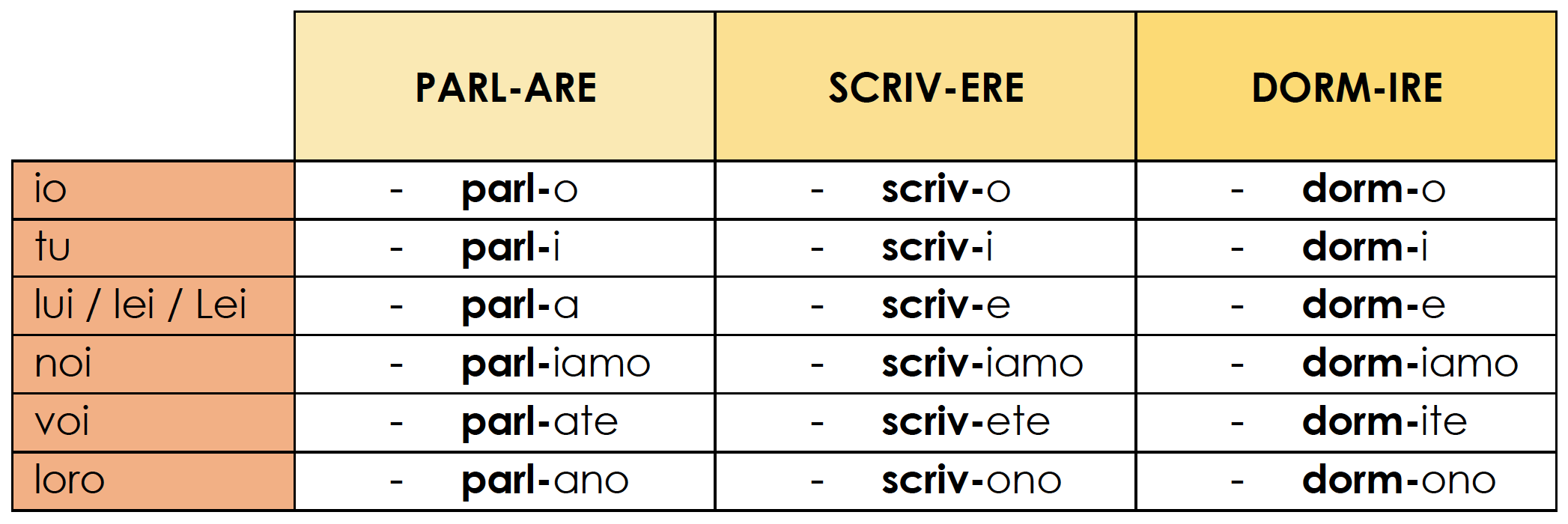Italian present indicative (indicativo presente)
Let’s start our journey through Italian verbs!
The present indicative is probably the first tense you’ll stumble upon during your journey through the Italian language. What is it? Let’s take a look together!
Uses of the present indicative
Verbs in the present indicative express actions, facts and situations that happen or are going on at the moment when we speak or write. This applies to:
(a) Actions and facts happening at the precise moment of speech:
Antonio parla con Emma. = Antonio speaks with Emma. / Antonio is speaking with Emma.
Note that in Italian, unless you really want to stress that the action is happening right now, you can use present simple and not differentiate between a simple form “speaks” and a continuous form “is speaking”.
(b) Something that happens regularly, with continuity or which is always true:
Ogni mattina vado a scuola in autobus. = Every morning I go to school by bus.
Gli italiani amano la musica. = Italians love music.
I cani sono mammiferi. = Dogs are mammals.
There are two situations in which the present indicative is used to refer to facts that are not in the present time:
(c) Referring to the future, as happens frequently in conversational situations:
Domani arrivano i miei amici spagnoli. = Tomorrow, my Spanish friends are coming.
L’anno prossimo compriamo una macchina nuova. = Next year, we’ll buy a new car.
(d) As a historical present, in order to make the description of past events more vivid. This is done when the events are described in a narrative way and is very common in history books and news reports:
Nel 1492 Cristoforo Colombo scopre l’America. = Christopher Columbus discovered America in 1492.
How to form the present indicative
Let’s start with the infinitive form of the verb, the one ending in -ARE (1st conjugation), -ERE (2nd conjugation) or -IRE (3rd conjugation). [Are you a bit confused about what a conjugation is? Head here!]
If the verb is regular, you have to start by taking off the last three letters of the infinitive.
parlare (to speak) = parl-are = parl-
scrivere (to write) = scriv-ere = scriv-
dormire (to sleep) = dorm-ire = dorm-
What you have left is called the ‘stem’. To this stem, you have to add the following endings. Be careful, as each group might have different endings for each person. Let’s take a look together:
Good news! As you can see, the endings for ‘io’, ‘tu’ and ‘noi’ are the same for all three groups. Now, let’s join the stems we isolated before with these endings to create the full form of the present tense.
And that’s it, the present tense is ready to use. Now you can use it to describe what is happening around you or to make future plans.
Antonio (= lui) parla con Emma = Antonio speaks with Emma
Antonio e Emma (= loro) domani parlano alla conferenza = Antonio and Emma are speaking at the conference tomorrow.
Io scrivo una mail = I write an email
Cosa scrivete (= voi)? = Guys, what are you writing?
Noi dormiamo molto = We sleep a lot
Mia sorella (= lei) dorme sempre = My sister is always sleeping
Unfortunately, there is a chance the verb you would like to use is not regular in the present tense. What should you do? I am afraid you have to know its conjugation and irregularities to use it. But don’t worry, most of these verbs are quite common, so the more you use them, the better you will remember them!
Let’s take a look at a table of the most common ones.
NOW IT'S TIME TO PUT WHAT YOU HAVE JUST LEARNT INTO PRACTICE!
Test yourself with this interactive exercise:




